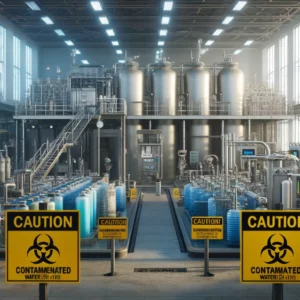Whistleblower Exposes Company’s Knowledge of Chemical Risks Dating to 1970s
In a startling revelation, former 3M scientist Kris Hansen has come forward about her 1997 discovery of PFAS chemicals in human blood samples and the company’s subsequent efforts to downplay the findings. Hansen, who was 28 then, recently disclosed that 3M executives had known about these “forever chemicals” in human blood for more than two decades before her discovery. The FOX 9 Investigators have obtained hundreds of hours of deposition videos showing 3M executives being questioned about their handling of toxic PFAS chemicals, revealing a pattern of deception that spans decades.
5 Key Points
- 3M knew about PFAS in human blood as early as the 1970s through independent scientists’ research.
- The company manufactured PFAS chemicals since the 1950s, with Scotchgard as a flagship product.
- Over 170,000 people in the Twin Cities east metro area have been affected by contaminated drinking water.
- 3M plans to cease all PFAS manufacturing by the end of 2025.
- The chemicals have been linked to various health risks, including cancer and immune system effects.
1997 Blood Sample Discovery Reveals Industry-Wide Impact
At age 28, 3M lab scientist Kris Hansen stumbled upon a discovery that would haunt her for decades: the company’s chemical signature appeared in blood samples from the general population. “It was like finding the big red 3M logo in the blood of the general population,” Hansen told FOX 9 Investigators. Her initial shock turned to cautious relief when senior executives assured her these chemicals posed no health risks. Their reassurances came from what she called “some of the highest-ranking people in the company,” whose words she trusted implicitly. That trust crumbled in 2018 when Minnesota’s civil lawsuit unearthed internal documents revealing 3M had long concealed information about potential health hazards.
Scotchgard Warnings Suppressed Since 1970s
Two decades before Hansen’s discovery, independent researchers had already sounded the alarm about PFAS chemicals in human blood samples. Their findings, documented in internal 3M memos, specifically identified the company’s popular Scotchgard product as a likely contamination source. Despite launching PFAS chemical production in the 1950s and watching Scotchgard become a commercial success, 3M buried these early warnings. The company continued manufacturing while withholding crucial information from its own scientists and the public. “I was horrified that there was that evidence of a cover-up,” Hansen said, reflecting on the documents revealed through Minnesota’s lawsuit. The company’s silence would have far-reaching consequences for public health research and environmental protection.
Twin Cities Water Crisis Affects 170,000 Residents
The environmental impact of 3M’s PFAS production has created a lasting crisis in Minnesota communities. More than 170,000 people in the Twin Cities east metro area now live with contaminated drinking water supplies, including Hansen herself. Decades of chemical waste dumping by 3M created an environmental hazard that refuses to dissipate. “That’s the thing about forever chemicals, they just move – they have high mobility in the environment,” Hansen explained, highlighting the persistent nature of PFAS contamination. “Which is why it’s so important to make responsible decisions because we’re stuck with them forever.” The contamination zone stretches across the east metro region, where residents face ongoing concerns about their water safety.
December 2024 Depositions Expose Executive Responses
Newly released deposition footage, obtained by FOX 9 Investigators, captures Hansen’s former supervisor, Dale Bacon, facing questions about PFAS chemicals detected in 3M workers’ blood. These hundreds of hours of recorded testimonies document executive responses to the company’s handling of toxic PFAS chemicals. For Hansen, watching these December 2024 depositions proved emotionally devastating. “I had a strong emotional reaction to watching [the depositions] because these are people I trusted – that I assumed were teammates to me,” she said. “I realize now that that trust was displaced.” The videos show how company leadership responded under oath to questions about their knowledge of PFAS risks.
Decades of Lost Research Time Impacts Public Health
3M’s decision to withhold early warning signs about PFAS chemicals stalled critical research into their health impacts by decades. Scientists have now linked PFAS exposure to an array of serious health conditions, including certain cancers, compromised immune systems in children, and heart disease. “We’ve seen effects on the immune system of children, heart disease, all sorts of things,” Hansen noted, adding, “Imagine if you could have known those things 20 or 25 years earlier.” While 3M has announced plans to stop manufacturing all PFAS chemicals by the end of 2025, Hansen emphasizes this action comes too late for many affected communities. The company’s spokesperson defended their record, stating that 3M “has been a leader in addressing PFAS-related matters” and pointing to their voluntary phase-out of some chemicals in 2000. However, for residents living in contaminated areas, these corporate responses offer little comfort as they continue to face the consequences of decades of PFAS exposure.
FAQ
Q: Can I file a lawsuit if I was exposed to PFAS or other forever chemicals?
A: If you or a loved one suffered health issues due to exposure to PFAS or other forever chemicals, you may be eligible for legal action. Contact our legal experts to learn about your rights and start a free, confidential case review.
Q: What did Kris Hansen discover about PFAS chemicals at 3M in 1997?
A: Hansen discovered 3M’s chemicals present in blood samples from the general population while working as a lab scientist at age 28. She described it as finding “the big red 3M logo in the blood of the general population.”
Q: When did 3M first know about PFAS chemicals in human blood?
A: Independent scientists alerted 3M about PFAS chemicals in human blood in the 1970s, more than 20 years before Hansen’s discovery. Internal memos specifically identified Scotchgard as a likely source of contamination.
Q: How many people are affected by 3M’s PFAS contamination in the Twin Cities?
A: More than 170,000 people in the Twin Cities east metro area have been affected by contaminated drinking water due to 3M’s decades of chemical waste dumping in the region.
Q: What health risks are linked to PFAS exposure?
A: PFAS exposure has been linked to various health risks, including certain cancers, effects on children’s immune systems, and heart disease. These “forever chemicals” do not break down naturally over time.
Q: When will 3M stop manufacturing PFAS chemicals?
A: 3M has announced plans to stop manufacturing all PFAS chemicals by the end of 2025. The company previously phased out some PFAS chemicals in 2000.
Q: What products contain PFAS chemicals?
A: PFAS chemicals are found in various household products, including waterproof clothing and non-stick cookware, and notably in 3M’s Scotchgard, which the company began manufacturing in the 1950s.
Q: How did 3M respond to Hansen’s discovery?
A: When Hansen reported her findings, company executives told her, “It’s unfortunate, but it’s okay – it’s not going to cause harm to anyone.” Internal documents later revealed through a 2018 Minnesota lawsuit showed the company had known about potential risks for decades.
Citations
Nathan O’Neal (December 15, 2024). Former 3M scientist who made ‘unsettling’ PFAS discovery says bosses deceived her. FOX 9 News. https://www.fox9.com/news/former-3m-scientist-unsettling-pfas-discovery-bosses-deceived-her







